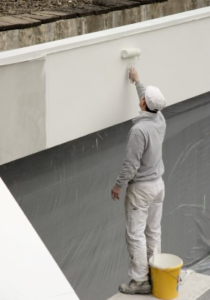Whether you’re revamping a residential space or opening a business, a floor coated with epoxy will last for years to come. It’s resistant to chemicals, stains, and scratches and can be brushed on or rolled on.
Epoxy is made of two components—a hardener and resin—that must be mixed immediately before application. It also requires time to dry and cure and is not conducive to DIY projects. Contact Supreme Coats Painting and Epoxy now!

Epoxy is a durable coating used in commercial and industrial spaces to provide superior durability, hygienic surfaces, and chemical and impact damage resistance. Like any paint, epoxy requires careful application and proper curing to achieve optimal results. Following the manufacturer’s application and curing recommendations is important to ensure a professional result.
In order for the epoxy to adhere properly, the surface must be cleaned and prepped. This includes removing dirt, oil, grease, or other contaminants from the surface. These should be removed with an appropriate solvent, such as acetone, lacquer thinner, or denatured alcohol.
The surface must then be sanded to a smooth finish. This can be done manually with a hand sander or mechanically with a drum sander. The sanding must be done to the appropriate grit for the type of coating that will be applied-check the coating’s instructions. It is best to start with 80-grit and work your way up to 120-180 grit, depending on the thickness of the coating that will be applied.
When sanding, it is important to be cautious and wear a dust mask. If the sanding dust is allowed to enter the air, it can be inhaled and cause health issues. Also, it is important to be aware of the surface that you are sanding and avoid touching it with your hands or fingers. The oils from your skin can contaminate the fresh sanded surface and lead to adhesion problems.
Epoxy coatings require a very precise mixture of resin and hardener in specific proportions. Mistakes during this process can have devastating effects on the outcome of the project. This is why it is generally recommended to hire a professional waterproofing contractor.
It is also important to note that epoxy paints and coatings emit potent fumes during application and curing. This is why it is imperative to work in a well-ventilated area. If you are working indoors, use fans to move the air around. If you are outdoors, consider using a heat gun to speed up the drying process.
Applying
Epoxy is a versatile material that’s used in a variety of applications, from coating and sealing a floor to creating a strong adhesive. It’s also used to make surfaces more durable, as it’s much tougher than standard paint. It can be applied to any surface and is available in a range of colors and mixes, including metallics. It’s popular in garages and workshops because it offers a bright, vibrant look that can brighten up an area. It’s also easy to apply, meaning it can be done without the need for a professional contractor.
Before the epoxy can be applied, it needs to be thoroughly cleaned and prepared. This can include degreasing, scrubbing, acid etching, and mechanical grinding. The floor will then need to be allowed to dry completely. If you are using a water-based product, this may take up to 24 hours. It’s important to check the manufacturer’s instructions for specific drying times.
Once the floor is ready, it’s time to apply the epoxy resin. This can be done either by hand or with a roller, depending on the type of product you are using. Epoxy has a short pot life, so it’s essential to work quickly when applying it. If you’re working alone, you should have an assistant to help speed up the process.
After the epoxy has been applied, it should be allowed to dry for up to 24 hours. A second coat may be necessary if you want to achieve an even finish. After this, you can use the area as normal, although you will need to sweep and mop regularly to keep it looking clean. Epoxy paint is resistant to chemicals, oil, moisture, and heat, so it’s an ideal choice for a workshop or garage.
It’s also a good option for high-traffic areas because it is durable and safe to walk on. This is due to the textured surface that it provides, which helps it meet UL and ASTM standards. It’s also slip-resistant and comes in a variety of shades, making it aesthetically pleasing as well as hardwearing.
Curing
Epoxy is an extremely strong, durable floor material that is used in a variety of commercial and retail spaces. It is available in a variety of colors and can be tinted to create a custom look. Epoxy is made up of two parts, a resin and a hardener. These are mixed together on site immediately before application, causing a chemical reaction that produces a hard, cured polymer structure. This process makes the epoxy highly resistant to abrasion, chemicals, and impact. It also resists stains, making it ideal for concrete surfaces that will be frequently exposed to oil and grease.
The best way to ensure that your epoxy will cure properly is to follow the manufacturer’s instructions. This will help to avoid common problems such as air bubbles, yellowing or discoloration, and insufficient curing. Thorough mixing is essential, as well as ensuring that the curing temperature is appropriate for the product.
Another important thing to keep in mind is that epoxy can emit powerful and harmful vapors while it is curing, so it is important to take safety precautions. This includes wearing gloves, eye protection, and a mask. It is also wise to test the product in a small area before applying it to the entire surface. This will allow you to gauge color, texture, and adhesion.
Once the epoxy is applied, it takes up to three days for the finish to be ready for light foot traffic. It will need to be cured for five to seven days before heavy machinery and vehicles can drive on the surface. If you are concerned about slipping and falling, an anti-slip additive can be added to the finish.
If you are looking for a less labor-intensive option, consider using latex acrylic paint with an epoxy additive. This will provide the strength of epoxy with the simplicity of paint, and it is much quicker to apply. In general, the only drawbacks to using this type of finish are that it doesn’t resist corrosion or abrasion as effectively as pure epoxy, and it can be slippery when wet.
Maintenance
The key difference between epoxy paint and epoxy coating is the amount of epoxy resin they contain. Epoxy coatings, which are thicker and offer greater durability, have a higher epoxy concentration than paints. This makes them a strong, long-lasting protective coating that resists chemicals, oils, heat, and moisture. They also provide an attractive, aesthetically-pleasing finish and can be colored or include metallic flakes to create a unique, eye-catching look.
Although epoxy floors are durable, they require routine maintenance to keep them looking their best. Regular inspections are essential to identifying potential damage, such as chips and cracks, and addressing them before they become worse. A thorough cleaning is also important to remove stains from oil, grease, or other contaminants.
When removing these substances, gentle tools and cleaning solutions are the best way to avoid damaging the epoxy coating and shortening its lifespan. Harsh chemical cleansers and abrasive tools will cause your epoxy floor to chip, scratch, and discolor over time.
For oil stains, we recommend using a high-quality degreaser to break down the substance and help it evaporate faster. Afterward, neutralize the area with an appropriate solvent. Isopropyl alcohol is an excellent choice, or you can use stronger cleaners like denatured alcohol or paint thinner, which will soften the epoxy and make it easier to remove with a scraper tool.
It’s important to note that the handling of any epoxy products containing diisocyanates onboard ship requires additional training for crew members. This training provides the knowledge and skills necessary to handle these hazardous materials responsibly, minimize risk of exposure, and maintain a safe working environment during painting operations.
As a final step, it’s crucial to allow your new floor to fully cure per the manufacturer’s recommendations. This process can take several days, so you’ll need to plan accordingly. During this period, it’s vital to protect your newly-finished floor with plywood or other covers to prevent debris and dirt from scratching or damaging the surface. During this time, it’s also important to follow all safety precautions and wear proper personal protective equipment (PPE). With proper care and maintenance, your beautiful new epoxy floor will continue to serve as the stronghold of your garage for years to come.


